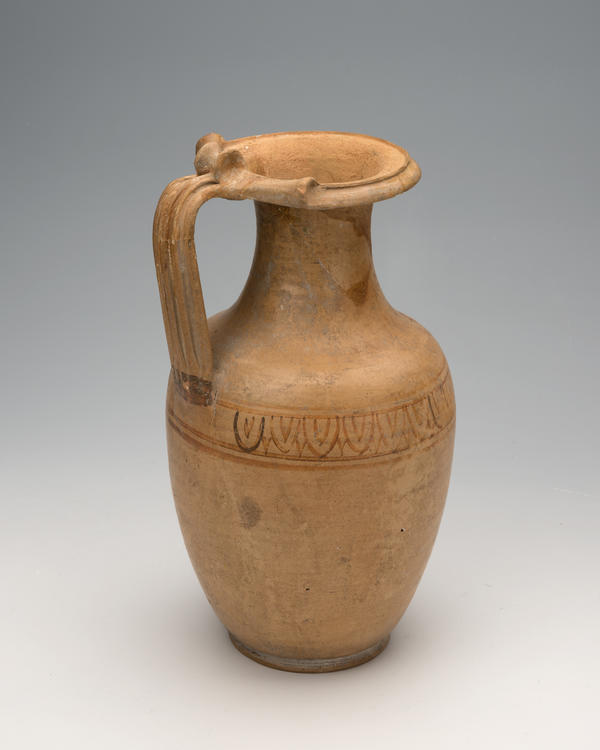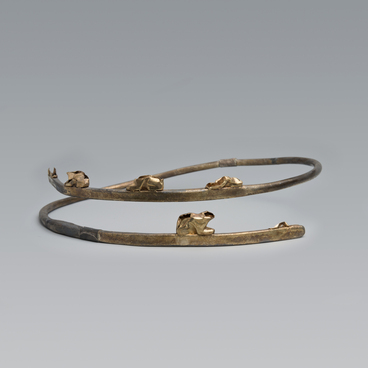Hydria is an ancient Greek vessel for water or wine. A similar red-clay jug with a high throat was found by archaeologists in the Rostov region near Vesely village in 1986. The vessel is decorated with floral ornaments with the image of a grapevine and solar symbols. One of the researchers and excavation authors, I. N. Parusimov thinks it is an image of an ivy vine with leaves and bunches of seeds. The ornament is made in orange-brown and red paint. Depending on the thickness of the paint layer, the paint is reddish-brown, in some places even black.
The jug was found in a tomb of a warrior — one of the Scythian noblemen. In addition to crockery, archaeologists also found a set of armour and weapons in the burial site. Interestingly, along with a Scythian stucco vessel, an elegant imported jug was found in the burial site. This means that there was a close connection between Mediterranean and nomadic cultures. And more and more new Greek goods have been introduced into nomadic culture.
Details and elements of decoration allow this jug to be attributed to the Pontic Olbia, an ancient Greek province. Its crown is decorated with pieces of clay that were ‘glued’ to the product in the course of manufacture. Masters of Olbia could have borrowed them from Rhodian-Ionian vessels, and the coil-shaped paste-ons — from bronze vessels. Probably the vessel from the collection of Azov Historical-Archaeological and Paleontological Museum-Reserve is an early sample of this group of ceramic.
Such vessels were made by ancient masters mainly for the wealthy citizens of Olbia. They were used as a tableware, and they were usually placed on the table during holidays and on special occasions. In the 5th — first half of the 4th century B.C., Olbia’s trade with the Scythians took on the greatest proportions. Goods could come to the Azov steppes in two ways. The first of them was the river route along the Seversky Donets. The second was across Meotida — that was the name of the Azov Sea and its coastal areas in ancient times, and then through Elizavetinskoye settlement, which is now located in the Krasnodar region.
The jug was found in a tomb of a warrior — one of the Scythian noblemen. In addition to crockery, archaeologists also found a set of armour and weapons in the burial site. Interestingly, along with a Scythian stucco vessel, an elegant imported jug was found in the burial site. This means that there was a close connection between Mediterranean and nomadic cultures. And more and more new Greek goods have been introduced into nomadic culture.
Details and elements of decoration allow this jug to be attributed to the Pontic Olbia, an ancient Greek province. Its crown is decorated with pieces of clay that were ‘glued’ to the product in the course of manufacture. Masters of Olbia could have borrowed them from Rhodian-Ionian vessels, and the coil-shaped paste-ons — from bronze vessels. Probably the vessel from the collection of Azov Historical-Archaeological and Paleontological Museum-Reserve is an early sample of this group of ceramic.
Such vessels were made by ancient masters mainly for the wealthy citizens of Olbia. They were used as a tableware, and they were usually placed on the table during holidays and on special occasions. In the 5th — first half of the 4th century B.C., Olbia’s trade with the Scythians took on the greatest proportions. Goods could come to the Azov steppes in two ways. The first of them was the river route along the Seversky Donets. The second was across Meotida — that was the name of the Azov Sea and its coastal areas in ancient times, and then through Elizavetinskoye settlement, which is now located in the Krasnodar region.



